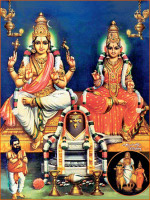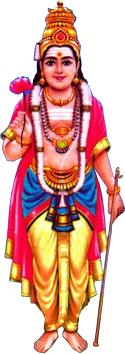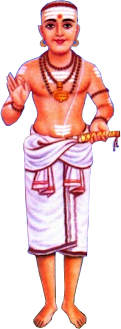
STORY OF GANGA
PRAY TO SHIVA WHO CAN ONLY CONTAIN THE TORRENTIAL FORCE OF GANGA......
The legend of Ganga, whose arrogance, before falling on the earth, was arrested by Mahadeva is narrated in Ramayana and other mythological legends in Hinduism.STORY OF GANGES COMING TO EARTH
The source of Ganga is at Gaumukh (the shape of the ice formation is like a cow's mouth), where the mighty river emerges from the depths of Gangotri glacier. The Gangotri glacier is situated at the height of4255 m above sea level and is approx 24 km in length and 7-8 km in width. Here the river is known as Bhagirathi after King -Bhagirath. Rising in the icy caves of Gangotri glacier, the gushing , tossing and gurgling Bhagirathi starts its long journey downwards where later it joins river 'Alaknanda' and becomes Ganga.
Ganga has a lofty position in the Hindu cultural beliefs. It is repeatedly invoked in the Vedas, the Puranas (old stories), and the two Indian epics, the the Ramayana and Mahabharata Ganga is a Goddess, Ganga Devi, one of two daughters of Meru (the Himalayas), the other being Uma, consort of Lord Shiva. In her youth, Indra had asked for Ganga to be given to heaven to soothe the Gods with its cool waters. The story of its descent to earth appears in slightly different forms in Ramayana (Bala Kanda: Vishwamitra narrates it to the child Rama), Mahabharata (Aranya Parba: Agastya narrates it to Rama), and in the Puranas. These myths are variously dated between 2000 to 400 BC. Let us see the interesting episode and this story teaches us a philosophical chord in our life if we want to reach the coveted goal. The general outline of the story is:
There was a mighty King Sagara was performing a great sacrificial ritual, which would herald him as the undisputed ruler over all earth. Little did he know that he was destined to be the instrument for fulfilling the cosmic drama being enacted elsewhere.
The king Sagara had two wives. By a favour of Lord Shiva, one wife bore him sixty thousand sons, all of whom were to die simultaneously, and the other bore him one son, Asamanjas, who would continue the dynasty. The sixty thousand sons grew to be great warriors, while the mighty Asamanjas caused so much misery to the populace that his father the king had to expel his own son, though a grandson, Ansuman, was left behind.
King Sagara defeated all the asuras (daemons) in the earth and wanted to stage a Ashwamedha Yagya (horse ceremony) to declare his supremacy. For this as was the practice prevalent in ancient times, in which a horse is allowed to roam at will, and is followed by warriors. Stopping the horse is a challenge to war; not stopping it is a compact of obeisance. In this instance, the sixty thousand sons were following the horse, but surprisingly, the horse was lost.
Meanwhile, fearing a challenge to his own throne, Indra disguised himself as a human being, went to the earth and laid his hands on the sacrificial horse of Sagara, as he feared the mighty Sagara could dethrone him. He hid it in the hermitage of sage Kapila. After much recrimination, King Sagara's armed men, led by his sons (60,000) dug up the entire earth and the underworld, the oceans, searching for the horse. Eventually it was found in a deep cavern, loitering close to where the sage Kapila sat in radiant meditation and held him responsible for this despicable act, though the sage knew nothing of the happenings as he was in deep meditation and felt his meditation was disturbed. The sage, in a fit of rage had merely gazed with trepidation and they were reduced to ashes, except for Prince Asamanjas.
King Sagara, upon hearing the news of the demise through Narada, the heavenly wanderer sent his grandson Ansuman to Kapila Muni's Ashram in the underworld and wants their souls to depart to heaven and approached the sage to check the after-effects. Kapila, on asking, informed the monarch that it was only Ganga who could purify the souls and liberate the souls and at that time she was running only in heaven. Despite much austerity and prayer, neither Sagara, nor Ansuman after him, nor his son Dilipa, could get Ganga to appear on earth.
Sagara went into penance after renouncing the throne to perform austerities to Brahma, but died without accomplishing the goal. Neither Anshuman nor his son Dilip were successful in this task. It was only the seventh descendant of Sagara, a just and noble King named Bhagiratha (King Dilip's Son), who could manage enough austerities to make Brahma appear before him. Brahma acquiesced, but warned him that the Ganga's flow would devastate the earth due to her torrential force. He advised him to pray to Lord Shiva who can only possess sufficient power to contain her.
After performing due penance, Lord Shiva, who appeared before him and agreed to receive Ganges in His matted locks. Ganga followed Brahma's diktat to descend to earth, but couldn't playfully resist the unwarranted and undeserved feeling that she could sweep away even the mighty Shiva in her forceful current. The Devas, Yakshas, Gandharvas and other Angels wanting to witness the scene of Ganga flowing left their abodes and assembled in the Sky. Due to this, the Sky appeared bright as though it was lit up by a hundred Suns. The fishes and snakes jumping around in the water looked like stars and lightning. The foam on the broad expanse of the water looked like swans.
Shiva, gauging her thoughts, decided to teach her a lesson. Spreading open His serpentine coils of hair He covered the entire sky, and collected all the waves of Ganga in his outspread locks. Her attitude, as though she could even sweep away Shiva to the nether world spoke of her haughtiness. Shiva on realising this attitude of hers, repressed her flow by storing her in his matted hair.
Then with a mighty swoop, he collected his hair, tied into a neat and tight bun, and captured Ganga in the infinite swirls and whirls of His hair. Ganga still flowed with tremendous force, but could not escape, and remained imprisoned and confined inside Shiva's hair. Bhagiratha, perplexed at the happenings, appealed to Shiva to release Ganga, so that she could wash away the sins of his ancestors, symbolized in their mortal remains. Shiva relented, and having arrested Ganga's arrogance, He released, but only three portion from His matted lock.
The water swelling up along the way made a thunderous roar and one could see a variety of fishes, tortoises, crocodiles and other creatures that live in water. This is the presumed site of the present-day temple at Gangotri. Bhagiratha led the way on horse back and the river followed. The Ganga which was running thus, flooded Janhu Maharishi's ashram and the Maharishi enraged on seeing her haughtiness drank the whole river. The Devas and others saluted the Maharishi and placated him saying that the Ganga, from then on will be his daughter. So the Maharishi let the Ganga out through his ears and that is how Ganga came to be known as Jhanvi.
In this manner they reached the spot where lay the ashes of the six thousand sons. They were thus liberated, and an ocean formed from the waters there. This is the Sagar Island of today, where the Ganges flows into the Bay of Bengal ("Sagara' is also Sanskrit for ocean).
Thus Ganga reached Patala - 'underworld' - and released the souls of his ancestors. King Bhagiratha's severe penance and perseverance dating back to seven generations, deep meditation and focus is called "Bhagiratha Prayarthan". We even use this to day to refer to one's unblemished goal in achieving dedication and determination.
The seven streams of Ganga are Bhagirathi, Janhvi, Bhilangana, Mandakini, Rishiganga, Saraswati and Alaknanda which merge into Ganga at Devprayag. The rock on which King Bhagirath is believed to have meditated, is called Bhagirath Shila and is located near the temple of Ganga.
Many other tales are associated with the Ganga and points on it. Hari (Lord Vishnu) himself bathed in its waters at Haridwar, which is so holy that sins as great as the murder of Brahmins may be washed away by bathing here. Hindus to this day use the water of the Ganga to cleanse any place or object for ritual purposes. Bathing in the Ganga is still the lifelong desire of India's masses, it is their bread and butter and they congregate on its banks for he Sangam, Sagar Mela or Kumbha Mela which are held in axis of rotation dueing auspicious days every few years.
Water from the Ganga has the recursive property that any water mixed with even the minutest quantity of Ganga water becomes Ganga water, and inherits its healing and other holy properties. Also, despite its many impurities, Ganga water does not rot or stink if stored for several days. To this date the water of holy Ganga is believed to have Amrit (nectar) in it. It has been studied by Scientists that the water collected from Ganga at its origin is in a pure state and even after being kept for several years, does not get contaminated.
Falling onto Shiva's head, where she meanders through his tangled locks, the mighty Ganga appears in this world after having been made more sacred by her direct contact with Shiva. Ganga's fall from heaven is replicated daily in the millions of Hindu temples where the water of the Ganga river is poured over the sacred Shiva Linga. Here it is important to note that the Linga of Shiva is often thought of as incandescent pillar of fire. By cooling the Shiva Linga with her soothing waters, Ganga is in a sense saving the world from Shiva's fiery Linga, whose extreme heat could destroy all life on earth. Bearing her on his head, Shiva becomes the facilitator for Ganga's smooth fall to the earth. But if Shiva saves the world from the power and force of Ganga's torrent, it is also Ganga, who in a similar manner, saves us from Shiva's scorching powers of destruction.
Let us re-enact pouring of holy water on the Shiva Linga on all days and particularly on auspicious MAHASHIVARATHRI DAY and attain the fame and name like Bhagiratha.









